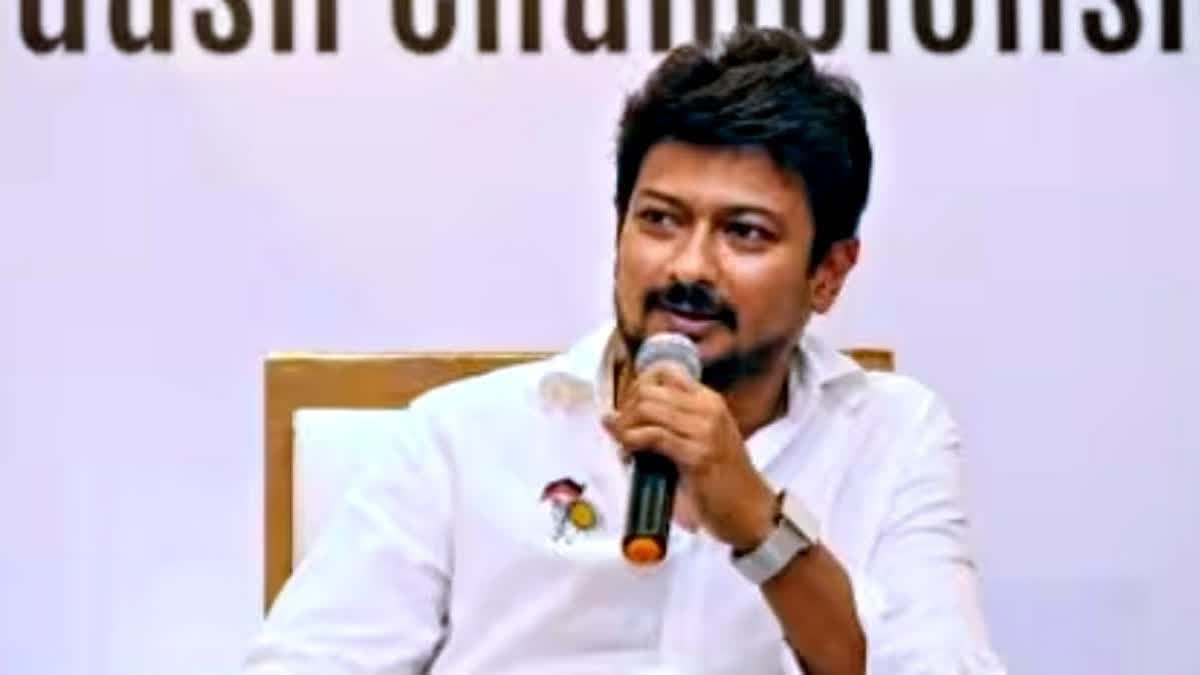Chennai (Tamil Nadu): In the face of outrage and a political campaign against his remarks on Sanatan Dharma, Tamil Nadu Sports Minister, Udhayanidhi Stalin, the crown prince of the ruling DMK, remains defiant. He can afford to be so and remain unscathed since the state has a centuries-old history of a counter-narrative preceding the Dravidian movement itself.
However, it has provided a handle to the BJP and the Sangh Parivar to beat the DMK, by painting it as anti-Hindu and creating a divide in the opposition INDIA alliance.
While Prime Minister Narendra Modi has tasked his Cabinet colleagues to give a 'befitting reply' to the raging debate, in the Dravidian heartland the controversy hasn't evoked any groundswell of opposition. It is no surprise that the young minister is not the first to debunk 'Sanatan', broadly understood here as adherence to rigid religious orthodoxy sanctioned by religious texts and hegemonic Brahmanism.
In modern times, from the late 19th century onward the anti-Brahmin counter-narrative took a mass character through the efforts of social reformers and thinkers like Pandit Iyothee Thass and later by the Justice party and the rationalist leader 'Periyar' EV Ramasamy.
Contesting the hegemony of Brahmins in bureaucracy and in other spheres, especially education, was the credo of the South Indian Liberal Federation (SILF), the precursor of the non-Brahmin movement. The manifesto of the SILF released on November 20, 1916, heralded the rise of a counter-political mobilisation to the Congress, led by Annie Besant, an apologist of Sanatan.
She vehemently opposed the demand for reservation for non-Brahmins in the Legislative Council. But, the Federation, later rechristened as the 'Justice Party', tasted victory, the first in its crusade. The Justice Party government brought the 'Communal Reservation', quota for non-Brahmins in public services, the first of its kind by an elected representative body.
In 1925 Periyar, an iconoclast, launched the Self Respect Movement, beginning another phase of Periyar's rationalist activism which targeted Hindu orthodoxy and caste/gender discrimination, equating them with sanatan. Brahmins and Sanskrit, seen as integral to this, are Aryan imports.
Hence, weddings sans Brahmin priests and rituals were promoted as Self Respect Marriages. He continued this campaign till his last breath. In his crusade against Brahminical hegemony and opposition to the primacy of Sanskrit over Tamil and Hindi imposition, he found support from Tamil scholars and Saivite Mutts. The 1937 anti-Hindi agitation would substantiate this. The Justice Party, renamed as 'Dravidar Kazhagam' (DK) in 1944, restricts membership to Brahmins.
The DMK, which seceded from the DK in 1949, gave up rationalism with the slogan “God is one, so is mankind”, taken from the Saivite savant Thirumular, endearing itself to the Saivite Mutts and its followers. However, it had not given up the fight against Hindu orthodoxy and Aryan hegemony.
Contestation to Sanatan is not recent with the advent of modernity, argue scholars and academics since it had been there in the Sangam Tamil literature right from the early centuries of the Common Era.
Renowned writer Jeyamohan, the scriptwriter of Maniratnam's magnum opus Ponniyin Selvan, maintains that Sanatan Dharma has been under attack in the south for more than 2,000 years. To substantiate, he says the 'Purananuru' (Anthology of 400 Heroic Poems) mocks Sanatan Dharma.
On his website, he argues that the Bhakti movement itself was a stiff response to Vedic tradition and supported the anti-Sanatan campaign of Viduthalai Chiruthaigal Katchi (VCK) leader Thol Thirumavalavan. “In the south, Sanatana Dharma is equated with Vedic tradition, opposed by Tamil Saivites and others including Jain and Buddhists,” he says.
According to Professor V Arasu, opposition to Sanatan was integral to Tamil culture. “It was there in Sangam literature. Then from Tamil Siddhars to Sri Ramalinga Adigalar (Vallalar) and Subramania Bharathi, we find the negation of Sanatan. Their poetic compositions are a stinging repudiation of orthodoxy and rituals with a search for egalitarianism,” he says.
Hence, the DMK remaining a dominant political force despite the attempts at painting it as anti-Hindu might puzzle many. It is historical and cultural, explains R Thirunavukkarasu, teaching Sociology at the University of Hyderabad. “If we consider the history of Tamil society as a continuum of contestation against birth-based location in socio-cultural fabric, its modern form is the Dravidian movement and the DMK is its successor. It draws its sustenance from the Tamil Saivite tradition,” he says, adding that Udhayanidhi has inadvertently taken it to another generation.
Also read: Sanatan Dharma should be fully respected, says T S Singh Deo



